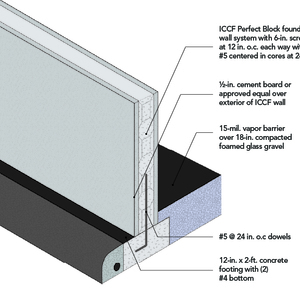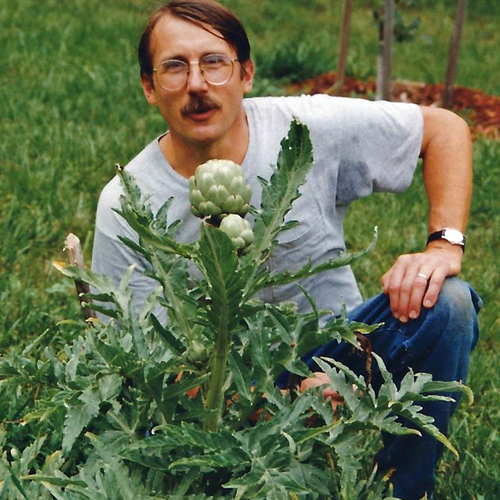
Image Credit: M. Maines
When people say that it costs more to build green, they are only half right. To build another generic house full of features that everyone is supposed to want but nobody really needs, using designer “green” products purchased at retail prices, would indeed cost more than building the same thing with conventional products. One of the keys to building green, though, is to think critically about every aspect of your home and to determine what is and is not necessary.
My wife and I are doing that with our house. We are also doing it with our landscaping. Our lot is 68’x110’ and was surrounded on three sides by large trees. Both the front and back yards were full of weeds and not much else. For a couple of years, we mowed the weeds, bagged leaves for municipal pick-up, and talked about what we should do about landscaping.
At the same time we were getting more into local food (slow food) and agriculture (permaculture). We started shopping more at farmers’ markets and Whole Foods, but we were careful about which items had “organically grown” labels because we were trying to stretch our food budget. We talked about growing a few things ourselves—vegetables that were expensive to buy and that tasted best right off the vine. Last summer we built three raised beds and enjoyed the bounty. In fact, we enjoyed it so much that we began planning out our landscaping to see just how much food we could grow ourselves. Our neighbors’ manicured lawns held little appeal, and we realized that small, well-planned gardens can be an attractive way to enjoy the outdoors.
The first thing we decided to plant were things that would take a few years to mature. We chose a variety of fruiting trees, vines and shrubs that are disease resistant, hardy for our location, and have a variety of uses. In our front and side yards, we planted plum and cherry trees, which can stand up to our northwest winter winds, as well as a variety of shrubs and a birch tree that will attract wildlife. We planted hops vines and rhubarb for perennial food and flavoring. We didn’t want the chemicals our neighbor uses to be near anything we’ll eat, so we created an allée (a stand of lilacs in traditional French gardening; we’ve also planted dogwoods in ours) between our houses.
In the backyard, we cut down some big trees on the southeast border and replaced them with a row of peach and cherry trees; the sensitive peach trees are in the most protected location we have. Several grapevines and highbush blueberries wrap around our deck, and two Precocious Hazelberts (a nut-producing shrub) are tucked under a tall oak tree. Native choke berries and winter berries will grow into a hedge along our shaded northwest boundary and provide winter food for birds.
For the main vegetable garden, we wanted to expand on the success we had with our first three raised beds. The French have a tradition of laying out their potagers, or kitchen gardens, in attractive yet practical patterns. Following the advice of generations of organic farmers, including Eliot Coleman, we will rotate plant families through the beds to maintain soil fertility and foil disease organisms. At 3’x 8’, the beds are easy to reach across; 12-in.-deep soil drains well and warms up quickly in spring. The beds are arranged along a center aisle that’s wide enough to accommodate a garden cart, and there’s room enough between beds for a lawnmower.
Trellises for tomatoes and cucumbers are easy to attach and reuse each year; growing vertically maximizes the sunlight and airflow these vigorous crops receive. Two “trench beds” complete the main garden; one for perennial flowers, which will attract beneficial insects; and one for potatoes this year, to be converted to more flowers next year. Instead of rototilling the beds each year, bringing weed seeds to the surface and destroying the soil’s texture, only the surface of the beds will be cultivated, followed with a topping of compost. The worms, fungi, and other organisms that live in the soil will toil for us relatively undisturbed, ferrying nutrients around and creating water-storing tunnels in the process.
Behind the raised beds are perennial raspberry beds, and along the back and side fences are linear beds for peas, beans, and summer and winter squash vines. A planter next to our garden shed contains various mint plants, which would take over the yard if planted directly in the ground.
We remind ourselves not to take all this too seriously, though. It is relaxing to wander among the plants in the evening to see what has changed and to ponder what we might do differently next year. Over time, our fruit trees will grow in, our gardening skills will improve, and our priorities will change. So far, it has been easy and fun to turn our backs on the conventional food system and do the most we can with what we have.
Weekly Newsletter
Get building science and energy efficiency advice, plus special offers, in your inbox.










One Comment
green building made affordable
I agree that using the "we think the same way as always" approach has spurred on the idea that "green" is expensive. Check out the book "Outside the Box" http://www.BuildOutsideTheBox,com. simple changes in framing make a much more efficient home at little or no extra cost over conventional approaches
Log in or create an account to post a comment.
Sign up Log in